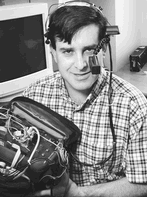

"At the grocery store, most people will wait until I'm past them, and then stop and stare," says Andy Fagg of the Computer Science faculty at the University of Massachusetts. Fagg, who is developing a wearable computer, is accustomed to the double takes. People don't generally see someone strolling through the frozen foods aisle wearing an apparatus that positions a tiny computer screen in front of his face.
"As general computing systems become smaller, we are reaching a point at which it becomes conceivable to don these devices as easily as shoes, a jacket, or a baseball cap," says Fagg. "This offers us access to information and communication resources at any time during our waking hours. It isn't about being able to write a paper or send e-mail while you're on line at the grocery store. It's about having digital assistance as you go about your life."
Fagg's aim is to teach the computer to 'notice' a user's routines and offer information accordingly. For instance, if the computer notices that he enters a conference room at a particular time, "it should figure out I'm going to a meeting and pull out appropriate documents, including minutes of the last meeting, and notes from related discussions." He offers another example: "I could tell the system I'm going to be cooking a certain recipe for dinner. The system will know what I have in the kitchen cabinets at home. If I drive near the grocery store, it wakes up and whispers, 'Don't forget to stop at the grocery store, and by the way, you need these three items for the dinner you want to cook tonight'."
The system is constructed from off-the-shelf components that Fagg put together "with a bit of my own soldering". It is not yet elegant. There is a handheld keyboard the size of a traditional computer mouse. Machinery is crammed into a blue canvas camera bag, with an odd assortment of wires projecting from it. Two batteries provide half of the device's six-pound weight. There is an assortment of serial ports and video ports, a headset with earphones and a video monitor, and a global positioning system (GPS) receiver, like the ones in upscale cars. Although the GPS receiver only works outside, "one of my projects right now is finding a way to provide similar information indoors," he says. When the screen is positioned correctly, it looks as though it's floating a few feet in front of the viewer.
One current challenge, Fagg says, is teaching the computer to interrupt him - politely. "The machine should present information at the appropriate time, and in the appropriate way. I don't care what I need at the grocery store if I'm sitting in my office," he points out. "Nor do I want it to convey information visually while I'm driving the car, although it's okay for it to occasionally whisper in my ear."
It's possible to make wearable computers because microprocessors are getting smaller every year, according to Fagg. Commercial wearable systems are already available, he says, although they are aimed at very specific industrial markets. "The systems are becoming more stable and more comfortable," Fagg says. "Ultimately, a lot of the bulk will be gone."
While some might see a wearable computer as a bit of a pest, Fagg sees it differently: "The machine doesn't nag you after the fact, when you've arrived at home and forgotten to buy the milk. It reminds you to pick up the milk when you're still in a position to solve the problem."
For further information contact Andy Fagg,
or see www-anw.cs.umass.edu/~fagg/projects/wearables
www-anw.cs.umass.edu/~fagg/projects/wearables

© Technews Publishing (Pty) Ltd | All Rights Reserved